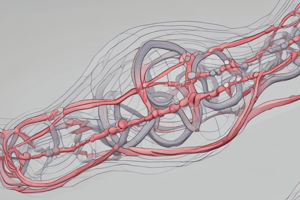Podcast
Questions and Answers
What is a characteristic feature of skeletal muscle cells?
What is a characteristic feature of skeletal muscle cells?
- They can undergo mitosis.
- They are multinucleated and long. (correct)
- They have a single central nucleus.
- They are located in the heart.
Which structure allows cardiac muscle cells to communicate effectively?
Which structure allows cardiac muscle cells to communicate effectively?
- T-tubules
- Intercalated discs (correct)
- Sarcomeres
- Synaptic junctions
What is a primary function of smooth muscle tissue?
What is a primary function of smooth muscle tissue?
- Contraction of the heart
- Support for nervous tissue
- Involuntary movement of internal organs (correct)
- Voluntary movement control
What type of cells make up the majority of nervous tissue?
What type of cells make up the majority of nervous tissue?
What role do neurons primarily play in the nervous system?
What role do neurons primarily play in the nervous system?
Which of the following correctly describes the shape of smooth muscle cells?
Which of the following correctly describes the shape of smooth muscle cells?
How do glial cells contribute to the nervous system?
How do glial cells contribute to the nervous system?
What distinguishes cardiac muscle cells from skeletal muscle fibers?
What distinguishes cardiac muscle cells from skeletal muscle fibers?
What is the primary function of dendrites in a neuron?
What is the primary function of dendrites in a neuron?
Which of the following correctly describes serous membranes?
Which of the following correctly describes serous membranes?
What type of tissue makes up mucous membranes?
What type of tissue makes up mucous membranes?
Which membrane is referred to as the cutaneous membrane?
Which membrane is referred to as the cutaneous membrane?
What is the main consequence of chronic inflammation?
What is the main consequence of chronic inflammation?
What is synovial fluid responsible for?
What is synovial fluid responsible for?
What does the suffix '-itis' indicate?
What does the suffix '-itis' indicate?
What characterizes the apical surface of the cutaneous membrane?
What characterizes the apical surface of the cutaneous membrane?
Flashcards are hidden until you start studying
Study Notes
Skeletal Muscle
- Skeletal muscle fibers maintain a constant number throughout life; they do not undergo mitosis due to their structure.
- Individual skeletal muscle fibers can increase or decrease in size but not in number.
- Skeletal muscle cells are long, multinucleated, and organized into bundles surrounded by connective tissue.
- Under light microscopy, skeletal muscle appears striated with peripheral nuclei.
Cardiac Muscle
- Cardiac muscle forms the walls of the heart and consists of cardiomyocytes.
- Cardiomyocytes are smaller than skeletal muscle fibers and contain a single, centrally located nucleus.
- Specialized junctions called intercalated discs connect cardiomyocytes, featuring desmosomes and gap junctions.
- Cardiac muscle is under involuntary control and pumps blood throughout the body.
Smooth Muscle
- Smooth muscle tissue facilitates involuntary movements in internal organs (digestive, urinary, reproductive systems) as well as airways and arteries.
- Smooth muscle cells are football-shaped, possess a single nucleus, and lack visible striations.
Nervous Tissue
- Nervous tissue comprises the brain, spinal cord, and peripheral nerves and exhibits excitability.
- Two primary types of cells in nervous tissue: neurons (signal transmitters) and glial cells (supportive cells).
- Neurons communicate via electrochemical impulses known as action potentials, triggering the release of signaling molecules.
Neuron Structure
- Neurons consist of three main parts:
- Cell body: Contains organelles and nucleus.
- Dendrites: Short branches that receive signals from other cells.
- Axon: A long projection that transmits signals to other cells.
Tissue Membranes
- Membranes may refer to cell membranes or tissue membranes, which are thin sheets of cells that cover various body structures.
- Four types of tissue membranes: mucous, serous, cutaneous, and synovial.
Mucous Membranes
- Composed of connective and epithelial tissues, mucous membranes line cavities and passageways that open to the outside environment, such as the digestive and respiratory tracts.
Serous Membranes
- Serous membranes line internal cavities that do not open to the exterior, secreting serous fluid for lubrication to reduce friction between organs.
Cutaneous Membrane
- The skin is the cutaneous membrane, a stratified squamous epithelium over connective tissue, providing a barrier against environmental factors.
Synovial Membranes
- Synovial membranes are connective tissues that line the cavities of movable joints, releasing synovial fluid for lubrication and nourishment of cartilage.
Inflammation
- Inflammation is the body's initial response to injury, with acute inflammation resolving over time through healing.
- Chronic inflammation can adversely affect homeostasis, with arthritis and tuberculosis as examples.
- The suffix "-itis" indicates inflammation of a specific organ or type.
Studying That Suits You
Use AI to generate personalized quizzes and flashcards to suit your learning preferences.




